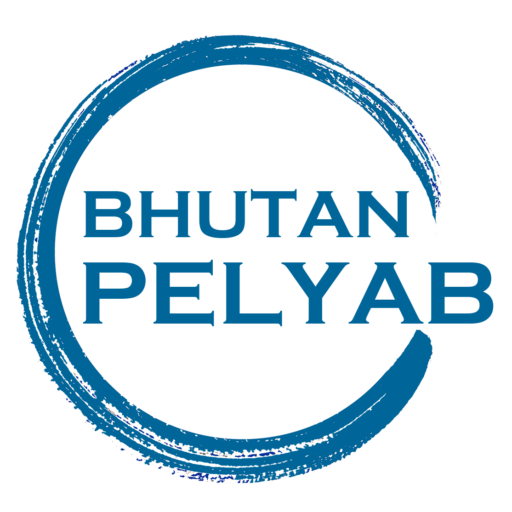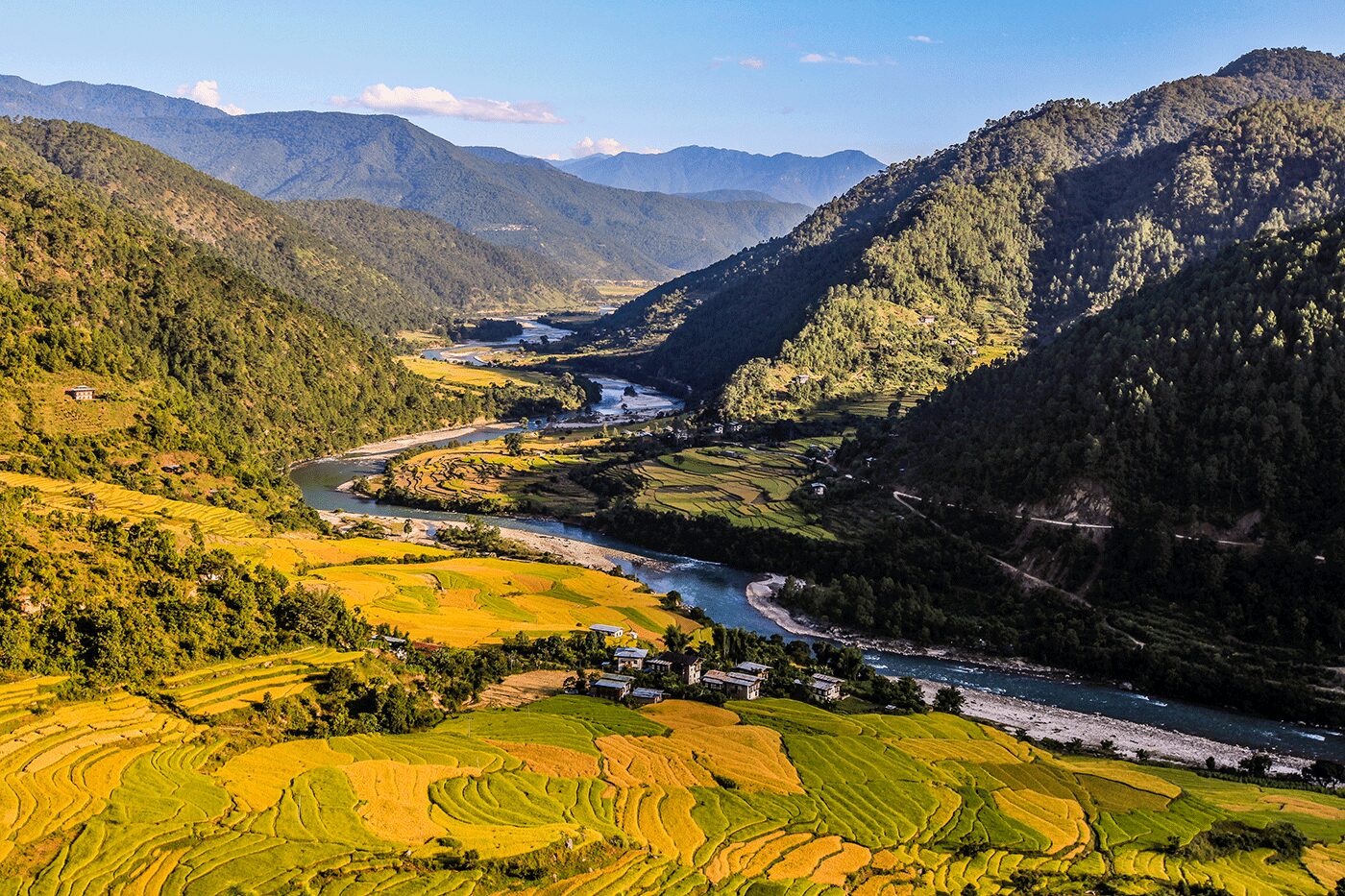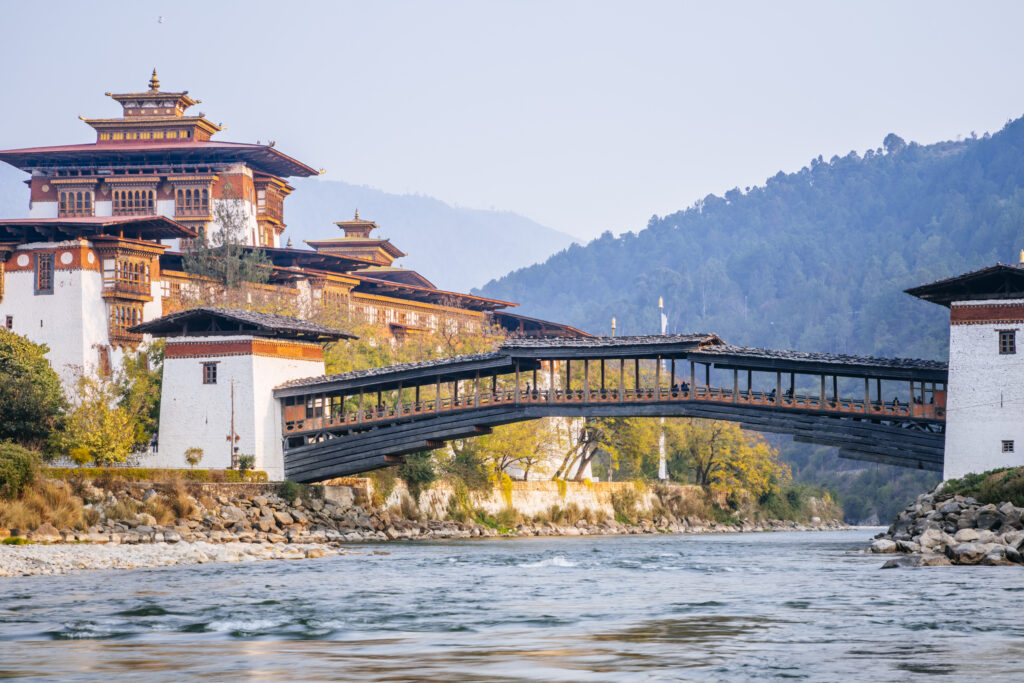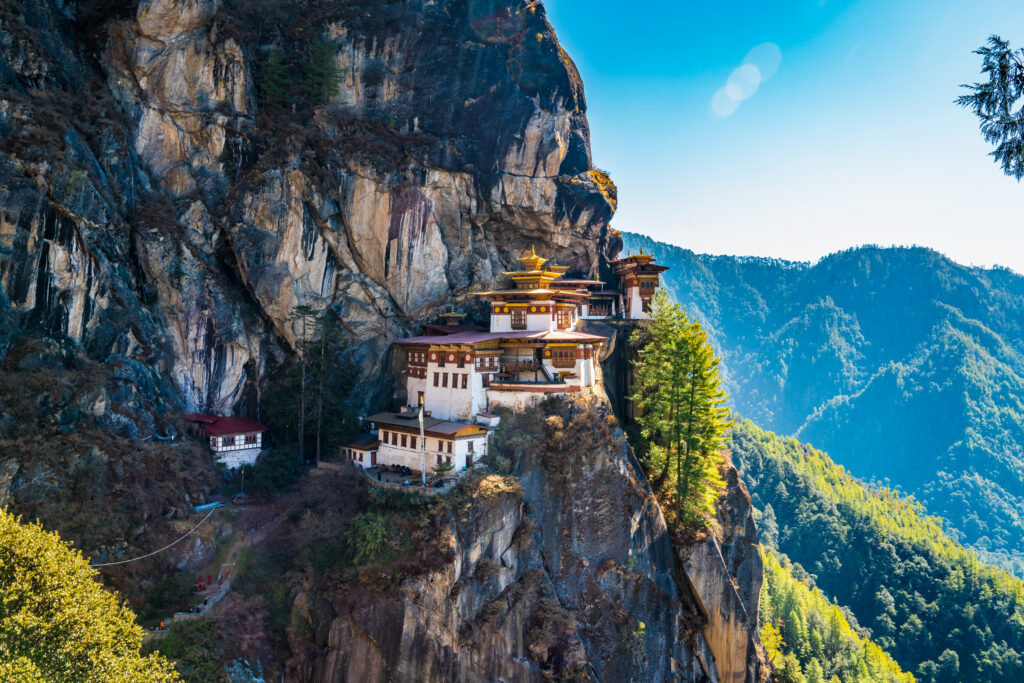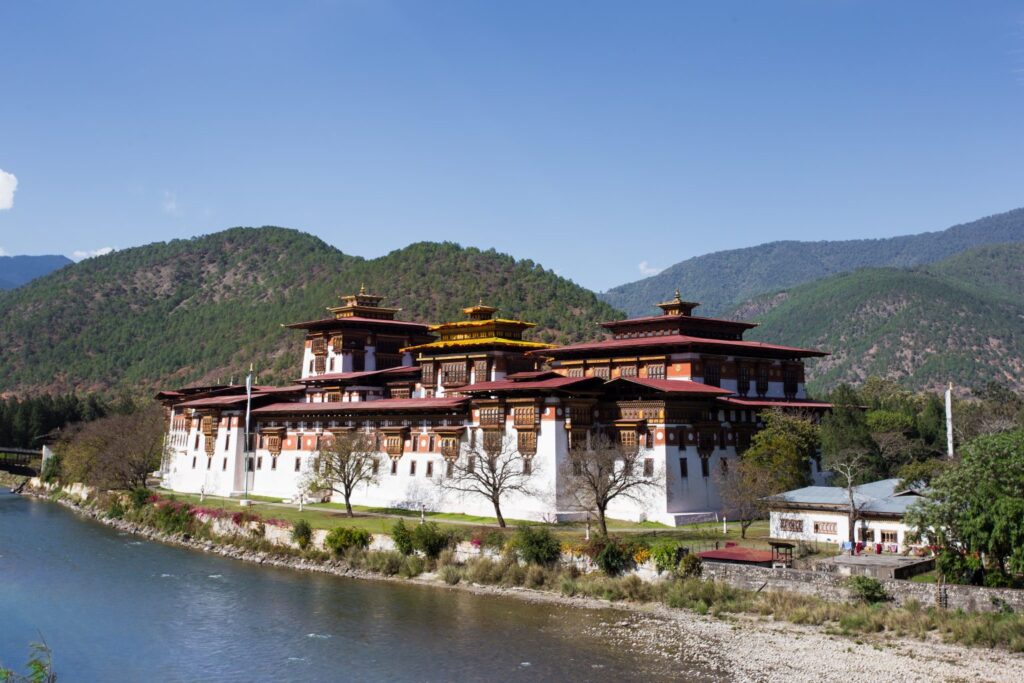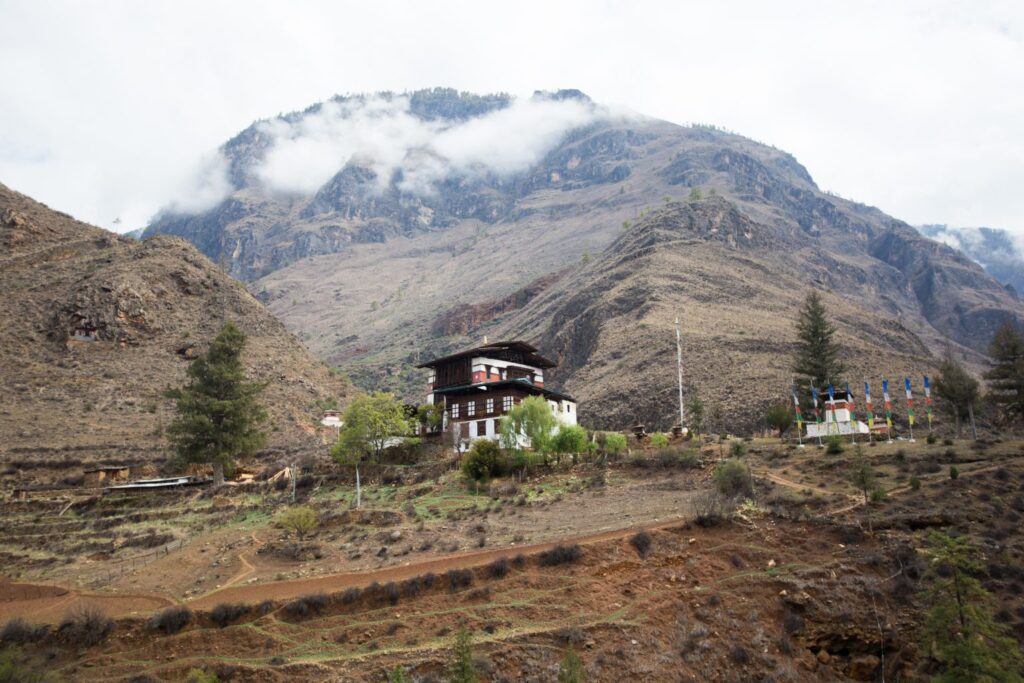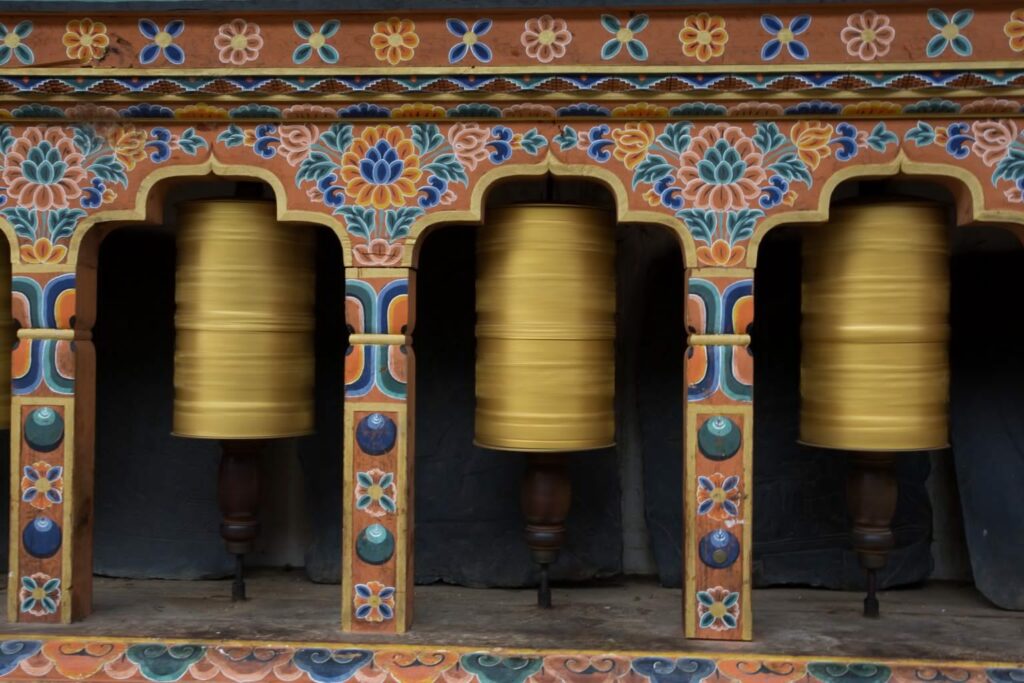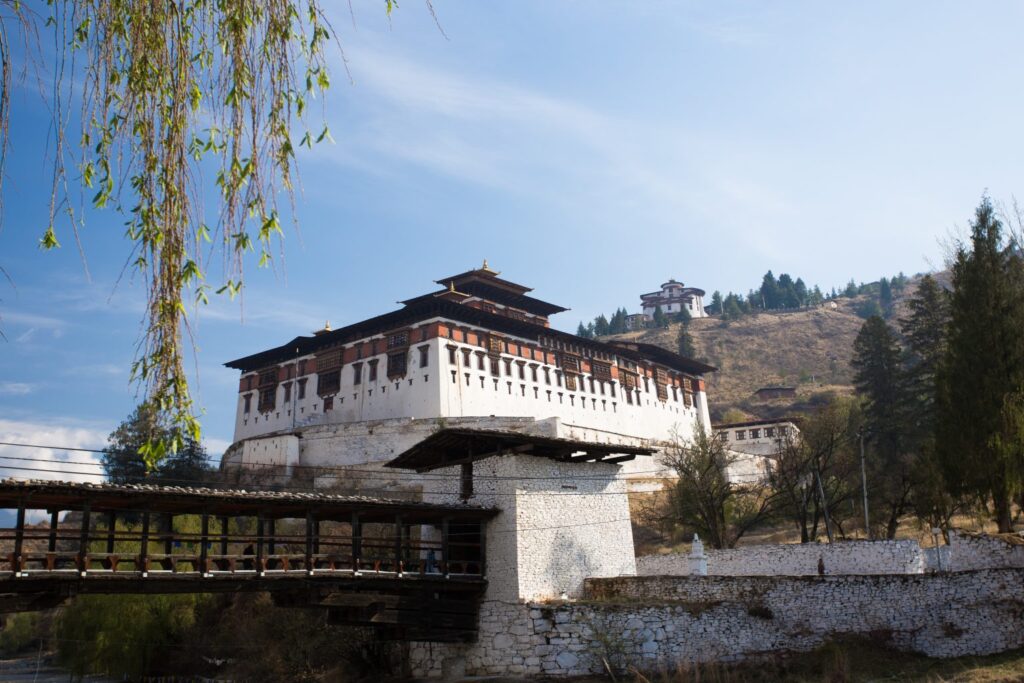Day 01: Arrive in Paro and travel to Thimphu
- Altitude in Paro: 2,300m
- Altitude in Thimphu: 2,400m
- Distance: 55km
- Estimated travel time: 1.30hrs
You will arrive at Paro International Airport. You will first be welcomed with the majestic picture of Himalayan snowcapped peaks while the plane approaching Bhutan. Meet up with our representative and we will drive to Thimphu, Bhutan’s capital. On the way, we will stop at Tachogang Lhakhang (Temple of The Excellent Horse). This impressive temple was the work of Thangtong Gyalpo (1385-1464), the legendary Bhutanese bridge builder.
At Thimphu, we will first see the National Memorial Chorten, erected by Bhutan’s Third King, His Majesty Jigme Dorji Wangchuk for world peace and prosperity. The iconic Tibetan-style building later became a memorial to the Third King after he passed away.
From the memorial, we will head to Buddha Point (Buddha Dordenma Statue), a giant 51.5m statue overlooking Thimphu valley. It is believed that the site fulfills a prophecy from the 8th century, emanating an aura of peace of prosperity to the entire world. Inside, you will see 125,000 smaller Buddha statues, cast in bronze and gilded.
Afterwards, we can take time to stroll around the dynamic streets of Thimphu. Wandering between shops and bazaars, between cafes, restaurants, and bars to see a different side of Thimphu, besides its historic landmarks.
We will stay the first night at the hotel in Thimphu.
Day 02: Thimphu sightseeing
Continuing to discover the capital, we will hike to Tango monastery in the morning. This is a moderate hike with an elevation gain of 400m, and it will take about 1 hour to reach the monastery. The trail will cross through beautiful forests of blue pine, oak and rhododendron. As we climb up the hill, we will walk through the lush alpine woods.
Tango monastery is a well-known university of Buddhist studies. Tango is the highest level of Buddhist studies, equivalent to the academic master degree. Situating at 2,800m, this structure was the work of the ‘divine madman’, Lama Drukpa Kunley, built in the 15th century. Furthermore, it is the residence of Gyalse Rinpoche, an important trulku (reincarnated lama), who is recognised as the seventh reincarnation of the fourth desi (secular ruler), Gyalse Tenzin Rabgye (the founder of Taktshang Goemba).
We will visit Changangkha Lhakhang after lunch. Bhutanese parents traditionally come to choose auspicious names for their newborns, or receive blessings for the young children. The temple stands on a cliff above the town, and you will find the tshomen (mermaid) shrine in the central courtyard. This place also has a great view from the back lore (pilgrim path), surrounded by black-and-gold prayer wheels.
Then, we will come to the National Institute for Zorig Chusum, commonly known as the ‘Arts And Crafts School’ or the ‘Painting School’. There is no better place to see and learn about the practice of Bhutanese traditional arts. It provides different courses, teaching from painting (thangkas – painted religious pictures, walls, and statues to the decorations on furniture and window-frames), to wood-carving (masks, statues), clay arts (religious statues, pottery).
Moving on, we will get to one of the most iconic constructions in Thimphu – Tashichho Dzong (Fortress of The Glorious Religion). Before being completely renovated and moved to the capital, the dzong, built in 1216 A.D, had gone through reconstructions over the years. The remarkable edifice sits next to the banks of Wang Chhu river, close to the town. Once we are here, make sure to catch the captivating flag changing ritual at 5pm. The ceremony begins in the courtyard and ends outside in the front of the dzong.
You will spend the second night at the hotel in Thimphu.
Day 03: Thimphu to Gangtey
- Altitude in Gangtey: 2,900m
- Distance: 160km
- Estimated travel time: 6hrs
The picturesque Gangtey (or ‘Phobjikha valley’) is our next destination. As we drive to Gangtey, we will have the chance to visit Dochula pass at 3,050m. This place is one of the most scenic mountain passes one will ever see, one of the few locations to enjoy the panoramic view of the eastern Himalayan ranges. The picture of 108 chortens gracing along the hillside with the backdrop of snowcapped Himalayan peaks is breathtaking and unforgettable.
Arriving in Gangtey, we will first explore Gangtey Goemba or ‘Gangtey monastery’. The legendary treasure finder Pema Lingpa had a vision that a goemba named Gangteng (hilltop) would be erected here, and his teaching would be spread from this place. Following the prophecy, Pema Thinley, the grandson and reincarnation of Pema Lingpa, built a Nyingma temple here in 1613. Located on the crest of a hill atop Gangtey valley, the monastery looks out to the fertile valley, where it is also the winter home of the rare Black Necked Cranes. The birds migrate from late October to March, and you can see them during this time of the year in Gangtey.
We will stay overnight at the hotel in Gangtey.
Day 04: Gangtey to Bumthang
- Altitude in Bumthang: 2,800m
- Distance: 158km
- Estimated travel time: 6hrs
Today’s journey will start with the scenic Gangtey Nature Trail. The pleasant walk will begin at the hilltop overlooking Gangtey Goemba, descend to beautiful flower meadows and trail towards the village of Semchubara. Following the trail, we will pass through ancient blue pine forest before heading down to a valley viewpoint. The hike will end once we reach the spectacular Khewang Lhakhang (Khewang temple).
After that, we will go to the Black-necked Crane Visitor Centre, where you will find out more about the rare bird species. In the winter, it is also a place to catch the sight of these special migrants.
Next, we will discover the spiritual heartland of Bhutan – Bumthang, comprising four smaller valleys namely Tang, Ura, Choekhor and Chumey. The region is home to some of the oldest palaces, Buddhist temples and monasteries in the entire kingdom.
On the way, we will have the chance to visit the Yathra Weaving Center. At the popular weaving center, you will find the intriguing process of weaving yathras, the local’s unique woven textile with deep colours and eye-catching designs. Besides, we will drive slowly and stop for refreshments and sightseeing.
We will stay the first night at the hotel in Bumthang.
Day 05: Bumthang discover
First place to explore for today is the famous Jambay Lhakhang, one of the sacred temples built by the 7th-century Tibetan king Songsten Gampo. It is believed the temples were erected in 659 in only one day to subdue a Tibetan demoness, and Jambay Lhakhang was to pin her left knee. The ancient temple was later visited by Guru Rinpoche and renovated by the Sindhu Raja after the Guru restored his life force.
After that, we will visit the imposing and important temple complex Kurjey Lhakhang. The sacred site is where the body (kur) print (jey) of Guru Rinpoche is preserved, located in a cave in the oldest of the three buildings of the complex.
We will then see the holy water at Kurjey Drupchu, located near Kurjey Temple. Kurjey Drupchu is believed to have been blessed by Guru Rinpoche himself.
From Kurjey Drupchu, we can either drive or walk to Tamshing monastery, our next stop. The walk will be around 1 hour. The building, formally called Tamshing Lhendup Chholing (Temple of the Good Message), is the most important Nyingma goemba in Bhutan. Established in 1501 by the great spiritual master Pema Lingpa, the site remained privately owned by his descendants until 1960. The unusual structure of the building was erected by Pema Lingpa himself, with the help of khandromas, who made many of the statues.
We will visit Wangduechhoeling Palace Museum And Cultural Centre. Built in 1858 by Trongsa Penlop Jigme Namgyel, father of Bhutan’s first king, the Wangduechhoeling (“victorious place rich in Buddhism”), the Palace Museum reopens in 2025 after careful restoration. This architectural gem blends 19th-century design with Buddhist artistic influences into a living celebration of Bhutan’s heritage. As the kingdom’s pioneering “living museum”, it integrates multimedia exhibits to immerse visitors in ancient royal traditions through innovative storytelling.
We will stay the second night at the hotel in Bumthang.
Day 06: Bumthang sightseeing
After breakfast, we will drive to Tang valley, the most remote area in Bumthang and visit the holy Mebar Tsho (The Flaming Lake). It is located along the way to Tang village. Legend says that Pema Lingpa had jumped into the lake with a butter lamp in his hand, and later emerged from the water with a paper scroll and a chest hidden by Guru Rinpoche, while the lamp was still burning brightly. Beautiful prayer flags are placed around the small sacred lake and there is also a small altar dedicated to Pema Lingpa. Moreover, on auspicious days, people will offer butter lamps at the lake.
Next, we will take Bushman hike. This hike will begin at the beautiful village at Tang valley and end at the imposing Lhodrak Kharchu Monastery. It will lead through a beautiful blue pine forest and offer us the incredible view of Bumthang Valley and the remarkable Jakar Dzong, which overlooks Chamkhar Valley.
After 3 hrs walking, we will arrive at Lhodrak Kharchu Monastery. The sacred monastery was blessed by Guru Rinpoche and it was also the seat where Nub-ben Namkhai Nyingpo became an accomplished Yangdag master. The edifice was established in the 1970s and you will find giant statues of Guru Rinpoche, Chenresig and Sakyamuni in its Tshokhang (assembly hall).
You may walk to the Chamkhar town and it is a 10-minute walk downhill from the monastery. After visiting the town, we will drive back to the hotel and stay overnight at the hotel in Bumthang.
We will stay the third night at the hotel in Bumthang.
Day 07: Bumthang to Mongar
- Altitude in Mongar: 1,600m
- Distance: 190km
- Estimated travel time: 7hrs
Our journey will continue eastwards, winding through rugged terrain to Thrumsingla pass. At 3,780m, it is one of the highest points on the road network. The road will eventually descend to Sengor valley, known for its incredible views of cascading waterfalls and lush hills of eastern Bhutan along the way.
The drive to Mongar is one of the most astonishing trips in Bhutan. Throughout the trip, we will be welcomed with the sight of sharp cliffs, untouched fir forests and green pastures, and also beautiful rhododendron gardens.
You will see here traditionally painted and decorated shops lining on the main street. There are rows of eucalyptus trees planted around the small town. The tranquil town is famous for its lemongrass, which is used to produce an essential oil.
Once we arrive in Mongar, we will start with a visit to Mongar Dzong, one of the newest dzongs in Bhutan. The building was only established in the 1930s, its construction remains similar to that of the previous sites, without plans or nails. This shows how Bhutanese traditional architecture has thrived through the centuries. Yet, unlike the others sitting on strategic positions, Mongar Dzong stands on a small slightly sloping area overlooking the town.
We will stay overnight at the hotel in Mongar.
Day 08: Mongar to Lhuntse
- Altitude in Lhuntse: 1,500m
- Distance: 75km
- Estimated travel time: 3hrs
Saying goodbye to the tranquil Mongar, we will head to Lhuntse. The region is the ancestral home of the Kings and hosts a number of the sacred sites of pilgrimage in the country. Lhuntse’s landscape is renowned with sheer cliffs towering above river gorges and verdant coniferous forests.
In Lhuntse, we will first visit Khoma village, known for Kishuthara – a fine quality weave with intricate patterns, made by the local women. The village produces some of Bhutan’s most sough-after and expensive Kishuthara weavings. The weavings are so elegant that they resemble embroidery and are used as kiras (Bhutanese women’s traditional clothes).
We will also stop at the Clay-pot making factory to see the local process of creating clay pots.
After that, we will get to the giant statue of Guru Padmasambhava in Takila. The statue has a total height of 52.7m (173 ft) and stands on the Takila mountain slope, overlooking the green valley of Tangmachu. The statue was built following a prophecy of two Buddhist masters that a statue of Guru Padmasambhva should be erected in Takila to prevent war and ensure the continued prosperity in Bhutan and in the world. Thus, the imposing figure was built by the late Ven. Khenpo Karpo Rinpoche, who is one of the masters of the present 5th King of Bhutan.
We will stay overnight at the hotel in Lhuntse
Day 09: Explore Lhuntse
In the morning, we will visit Dungkar Naktshang, the ancient home of the Dungkar Chojie and the ancestral home of the Wangchuck Dynasty. The building is located amid a striking backdrop of immense mountains overlooking the small Dungkar village. The Dungkar expedition is a thrilling and magical voyage into Bhutan’s past.
After lunchbreak, we will go to Lhuntse Dzong, or popularly known as Lhundub Rinchentse. The ancient structure stands on a rocky outcrop overlooking the fertile Kuri Chhu valley, with near-vertical drops on all sides. The dzong was established in 1654 by the Trongsa penlop Mingyur Tenpa, on the site where Pema Lingpa’s son Kuenga Wangpo previously erected a small goemba.
We will stay overnight at the hotel in Lhuntse
Day 10: Lhuenste to Bumthang
- Distance: 209km
- Estimated travel time: 8hrs
Today, we will have breakfast before travelling to Ura valley, the highest out of the four valleys in Bumthang district with sightseeing en-route.
The drive to Ura will take quite some time so we will have multiple stops for refreshments. On arrival in Ura, we will stay at Singkhar village. Here we can learn more about the local life at the highest valleys in Bumthang, see the traditional houses and also visit the temple in the village. The people here are mostly sheep and yak herders.
We will stay overnight at the farm house in Ura valley.
Day 11: Bumthang to Trongsa
- Altitude in Trongsa: 2,200m
- Distance: 80km
- Estimated travel time: 3hrs
Leaving the scenic Ura valley, we will drive to Trongsa – a charming town situated on a sheer ridge. The historic town is known as the gateway to the east of Bhutan and also renowned for breathtaking scenes of the deep valleys surrounding it.
Trongsa Dzong, our first stop in the town, sits high above the roaring Mangde Chhu river. The complex is perhaps the most spectacular sited dzong in the country, with a sheer drop to the south that disappears behind the thick veils of cloud. The dzong’s buildings trail down the ridge and are connected by a succession of alley-like corridors, wide stone stairs and lovely paved courtyards. The massive structure, built in 1644, is easily visible from anywhere in town and remains a captivating sight to behold. This is also where the famous Trongsa tsechu is held annually in the northern courtyard, during December or January.
Trongsa is also home to an impressive museum. The watchtower of Trongsa has been turned into a museum about the Wangchuck dysnasty, and is a great place for you to understand more about the kingdom’s history.
Then we will take a 1-hour drive to explore Kinga Rabten, the winter palace of Bhutan’s 2nd King. The visit will show us a great insight into the early days of Bhutan’s monarchy. Not only that, the drive itself is quite picturesque as we will pass below Takse Goemba, a huge waterfall and the fertile rice paddles of the lower Mangde Chhu valley.
From the palace, we will hike or drive to visit Karma Drubdey Nunnery, home of about 127 Buddhist nuns. As the nunnery is located high up on a hilly area, surrounded by mountains on all sides and is a very secluded place with plenty of fresh air, it makes a perfect place to study and retreat for the nuns. It is also the last stop for today, we will return to the hotel in town afterwards.
Day 12: Trongsa to Punakha
- Distance: 150km
- Estimated travel time: 5hrs
- Altitude in Punakha: 1,300m
Parting with the historic Trongsa town, we will drive to Punakha – Bhutan’s old capital. Our first stop in the old capital is the renowned Punakha Dzong (Palace of Great Happiness), also the former seat of the Bhutan government until the 1950s. The grand building was built in 1637, and was the second dzong erected in the country.
Just passing the beautiful dzong, we will come to another famous landmark – Pho Chhu suspension bridge. With 160m length, it is the longest suspension bridge in Bhutan, and you will see the charming sight of colourful prayer flags gracing the bridge. From the bridge, you will be welcomed with the incredible view of Punakha Dzong and the alluring land of Pho Chhu valley.
We will have lunch and next enjoy the scenic walk-through rice fields and pine trees to get to Khamsum Yuelley Namgyal Chorten. It will take about 1 hour to hike to the stunning chorten, which sits on a ridge above the lush valley at an altitude of 1,500m. The site is ranked as a high point in Bhutanese architecture. The unique structure was established by Her Majesty the Queen Mother for the wellbeing of the whole country as well as for the long life of our beloved King. The chorten also offers a magnificent view of Punakha valley that is not to be missed.
Tonight, we will stay at the hotel in Punakha.
Day 13: Punakha to Paro
- Distance: 125km
- Estimated travel time: 4hrs
After exploring the old capital, we will return to Paro. On the way, we will have an enjoyable walk to Chimi Lhakhang (Temple of Fertility), passing through verdant hillock fields. The temple is popular as childless women will come here to pray and receive a wang (blessing or empowerment). The hike will be only for 25 minutes and we can also see the farmers working once we pass the farm lands of Lobesa village.
Later, we will visit the astonishing Paro Rinpung Dzong (Fortress of The Heap of Jewels), founded in 1644 under the order of Zhabdrung Ngawang Namgyal. The prominent dzong is the administrative seat of the district of Paro. The complex is visible throughout the whole valley with its captivatingly giant buttressed walls, and is one of the greatest examples of Bhutanese architecture that we have the chance to visit.
Right next to the impressive dzong is the former watchtower of Paro – Ta Dzong, or the National Museum of Bhutan. We will see that the building has an unusual design in the shape of a conch shell, and gain a deeper understanding about the land of Bhutan. The museum houses a fascinating collection, from some of Bhutan’s finest art specimens to daily objects, masks, weapons, and armours.
Tonight, we will stay overnight at the hotel in Paro.
Day 14: Paro sightseeing
“If you have never been to Tiger Cave Temple, your trip to Bhutan is not complete.” The sentence alone has already shown the importance of the sacred Taktsang Monastery (or ‘Tiger’s Nest’) to the Bhutanese. Clinging to a steep cliff at more than 3,000m, the hike to the monastery will take approximately 4-5 hours. The trail is 4.5km one way, and has an elevation gain of 900m. During the trip, we will have stops to enjoy the incredible view of Paro landscape, from the untouched dense forests to the enormous Himalayan mountains. The spectacular natural scenes are always one of the most precious memories of travelers about Bhutan.
After the holy Tiger’s nest, we will visit Kyichu Lhakhang, one of the oldest and most imposing temples in the country. It is said that the Tibetan King Sontsen Gampo built 108 temples in the Himalaya in the 7th century, and Kyichu Lhakhang is one of them. These temples were erected to pin down a demon that tried to stop the spread of Buddhism to the people. Visitors are intrigued not only with the grand temple’s structure, but also with the beautiful scene of pilgrims constantly shuffling around the temple and spinning its many prayer wheels, so make sure you will not miss this.
We will have a special meal with a local family in the late afternoon. This is a nice opportunity to chat with the locals, listen to their stories while having a taste of the authentic Bhutanese dishes.
We also recommend a nice hot stone bath to relax your body after a day of hiking, or spend time wandering through the cool pubs and shops in Paro. The town is well-known for its nightlife with great live music and delicious snacks and local alcohol for one to discover, marking your last night in Bhutan.
We will stay the last night at the hotel in Paro.
Day 15: Depart Paro
After breakfast at the hotel, your guide will accompany you to the airport for flight to your onward destination. Tashi Delek (goodbye and good luck) and we hope to see you again!
